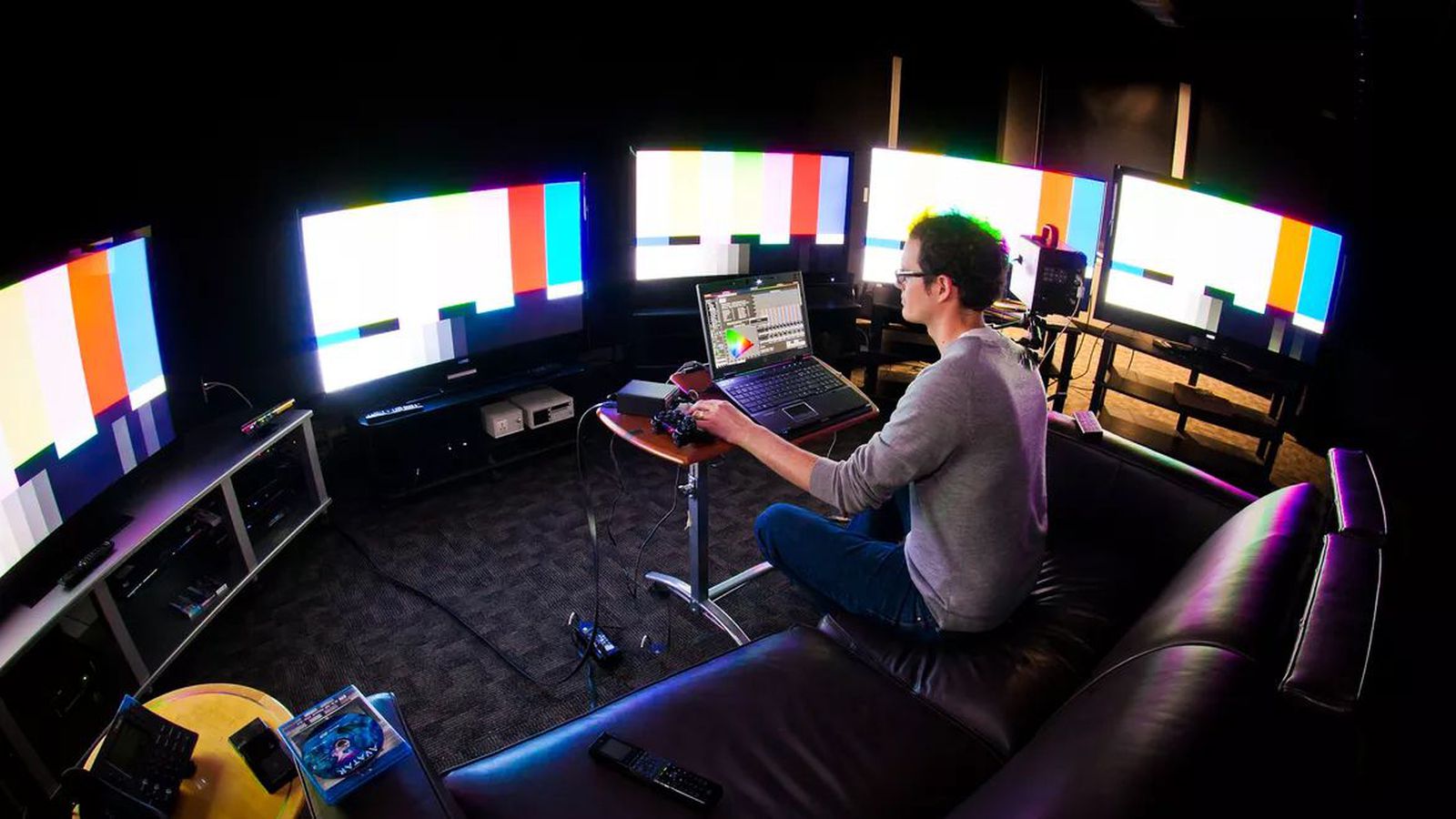
From TV salespeople to TV reviewers, you’ll often hear the word “calibrate” thrown around. TV calibration is often claimed to improve performance, increase accuracy and even make the TV less power hungry.
But does it? And at what cost?
Most calibrations cost a few hundred dollars (or pounds). So this brings up two questions: What is calibration, and is it worth it?
Contents
Calibration vs. setup
First some semantics. Often the words “calibration” and “setup” are used interchangeably. This is incorrect. Setup is what you can do with the basic TV controls with either just your eye, or — even better — with one of the many excellent setup Blu-ray discs available. Calibration requires specialized test equipment (which we’ll discuss in a moment), and a trained calibrator who knows how to use it.
If you want to start with the absolute basics, here’s my beginner’s guide to how to set up an HDTV.
Setup is what everyone should do with their new TV. Getting the basic picture settings correct can go a long way in getting your TV to look its best. You can do much of what a trained calibrator will do, just by using one of the aforementioned setup discs. Calibration costs money, and while it will get the most out of your TV, the difference between a calibrated TV and a correctly setup noncalibrated TV isn’t massive. At least, not any more.
What goes on
First let’s go through what happens if you hire a calibrator.
If you haven’t done anything to your television, their first job is ensuring it’s set up correctly. This can include checking you have the right cables connected, that your sources are outputting the correct resolution, and so on. If you’re new to all this, having a professional look over your gear can be quite handy.
Then, using either a setup disc or a test pattern generator, the calibrator goes through all the TV’s settings to make sure it looks its best. This includes correctly setting the contrast and brightness controls to make sure the TV is as bright as it should be for your viewing environment, and has the best black level possible without obscuring shadow detail.

Geoffrey Morrison/CNET
All of the above you can do yourself, with one of the aforementioned setup discs. The next step, though, you really can’t.
Adjusting a TV’s color temperature correctly isn’t something you can really do with your eye. Sure, you can think you picked the correct temperature just by looking at it, but as I explain in my article on color temperature, it’s nearly impossible to do correctly. Check out the three images to the right. Which one is correct?
When it comes to color temperature the eye can be fooled, so a calibrator uses a measurement device to measure the color temperature of the display. (CNET uses a Konica Minolta CS-2000 spectroradiometer for this.)
The goal is to get white as close as possible to the D6500 standard used throughout the film and TV world. This ensures that your TV looks as close as possible to what the director of the movie or TV show intended.
Some TVs also allow the adjustment of the actual color points, meaning a calibrator can make all colors more realistic. Done right, and on TVs that support it, it’s one of my favorite aspects of calibration. I love accurate colors and wouldn’t own a TV that didn’t have accurate color. Not all calibrators can adjust color points accurately, as it depends on the measurement equipment used and your TV’s available controls. If this interests you, it’s worth asking about beforehand.
To add another wrinkle, today’s high dynamic range and wide color gamut TVs require additional, specialized calibration. This too requires special training and equipment, and is also worth discussing before you hire a calibrator.
The benefits
A correctly calibrated TV will likely look more pleasing to the eye, and may — depending on its light output afterward — draw less power and even last longer. Calibration can result in a dimmer picture than the default settings, and if the TV is producing less light, it uses less power and can enjoy a longer lifespan thanks to reduced strain on the light-generating parts of the TV. Though “dimmer,” the image is typically more pleasing and easier to watch, especially at night. The image looks more “natural.”
Certain companies have a relationship with the Imaging Science Foundation, one of the leading companies that offers training for calibrators. TVs from these companies have specific calibration-friendly picture modes, such as ISF-Day and ISF-Night. These allow different settings depending on the amount of light expected in the room, making sure the TV looks its best regardless of the time of day.
In many cases, if someone isn’t familiar with what a calibrated TV looks like, they’re probably not going to like it… at first. A correctly calibrated TV will appear, to the uninitiated, reddish and soft. This is because the accurate color temperature is far warmer (redder) than how most TVs look out of the box. The sharpness control — often set very high — adds an artificial edge to everything. This masks real detail, but when you take it away, the image initially appears soft, even though it’s actually showing more fine detail.

Sarah Tew/CNET
It costs at least $250. Do you want it?
The cost of a calibration varies, but a good baseline is Best Buy’s Geek Squad TV calibration, which starts at $250. Other specialty retailers charge more or less and there are a lot of variables, for example how many different sources are accounted for or whether HDR is included.
Is this worth it for you? I can see both sides of this, though it’s hard for me to be unbiased, as I can calibrate my own TV. Despite what proponents of calibration tell you, the difference between most TVs calibrated and uncalibrated isn’t huge. This difference is getting even more narrow, as the better modern TVs tend to be relatively accurate out of the box (i.e. before calibration) in their best picture settings. Not perfect, mind you, but significantly closer than TVs from 10+ years ago.
So if you put the TV in the Movie or Cinema preset, choose the “warm,” “low,” or in some cases “medium” color temperature mode, and you use a setup disc to get your other settings correct, it’s going to be “close enough” for most people, and likely more than adequate.
How to find trained calibrators
Two main companies train people to become professional calibrators: these are the Imaging Science Foundation and THX. You can find calibrators in your area at those links. Best Buy’s Geek Squad also promotes ISF-Certified calibrators.
I’m an ISF-Certified calibrator myself, having gone through the training. So is CNET TV reviewer David Katzmaier. I haven’t been through the THX training, but I’m familiar with it.
In both courses, trainees are taught the basics of TV setup and the advantages of calibration. Then they’re shown how to calibrate a television. THX claims its course is more “hands-on,” though both do an excellent job.
Other DIY options
You could buy a cheap color meter yourself for less than a professional calibration, but I don’t recommend it. Even if the device is accurate, the learning curve is pretty steep and the kind of easy auto-calibration found in computer monitor devices from companies like Datacolor and X-Rite simply isn’t available in today’s TVs — at least not at prices a hobbyist can afford.
Another shortcut to calibration is copying someone else’s settings from the web. This isn’t as useful as it sounds. Every TV is different, so one person’s settings aren’t going to be the correct settings for your TV. Sometimes the difference might just be a few clicks in either direction. Other times, the difference can be huge.
CNET has a forum dedicated to TV picture settings where users can post and discuss settings for various TVs. CNET TV reviewer David Katzmaier posts settings there for every TV he reviews. He no longer posts detailed numbers for color temperature and some others, however, because those vary too much per individual TV. It can be a good place to look for basic settings, however.
Red, green and blue
The most important thing I hope you take away from this article is: no matter what you do to make the picture more accurate, give yourself some time to adjust. Your brain will, at first, be convinced that the accurate color temperature is inaccurate. Trust that it is accurate, and give it a few days. After that, you won’t be able to go back to the cool, bluish color temperatures of lesser, uncalibrated TVs.
If you’re a do-it-yourselfer, you can get your TV most of the way there with a setup disc and a bit of your time. A good calibration will get it the rest of the way, making your TV look as good as possible. With most TVs hiring a pro won’t make a huge difference, but if you want assurance that your new TV looks its best, it might be worth the price for you.
Got a question for Geoff? First, check out all the other articles he’s written on topics such as why all HDMI cables are the same, TV resolutions explained, LED LCD vs. OLED and more.
Still have a question? Tweet at him @TechWriterGeoff then check out his travel photography on Instagram. He also thinks you should check out his bestselling sci-fi novel and its sequel.
[“Source-ndtv”]










